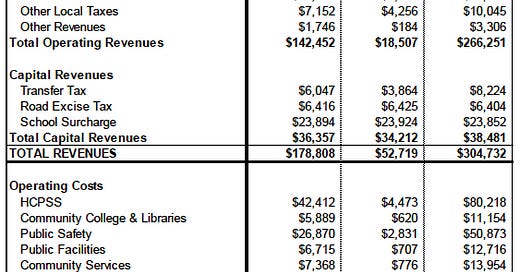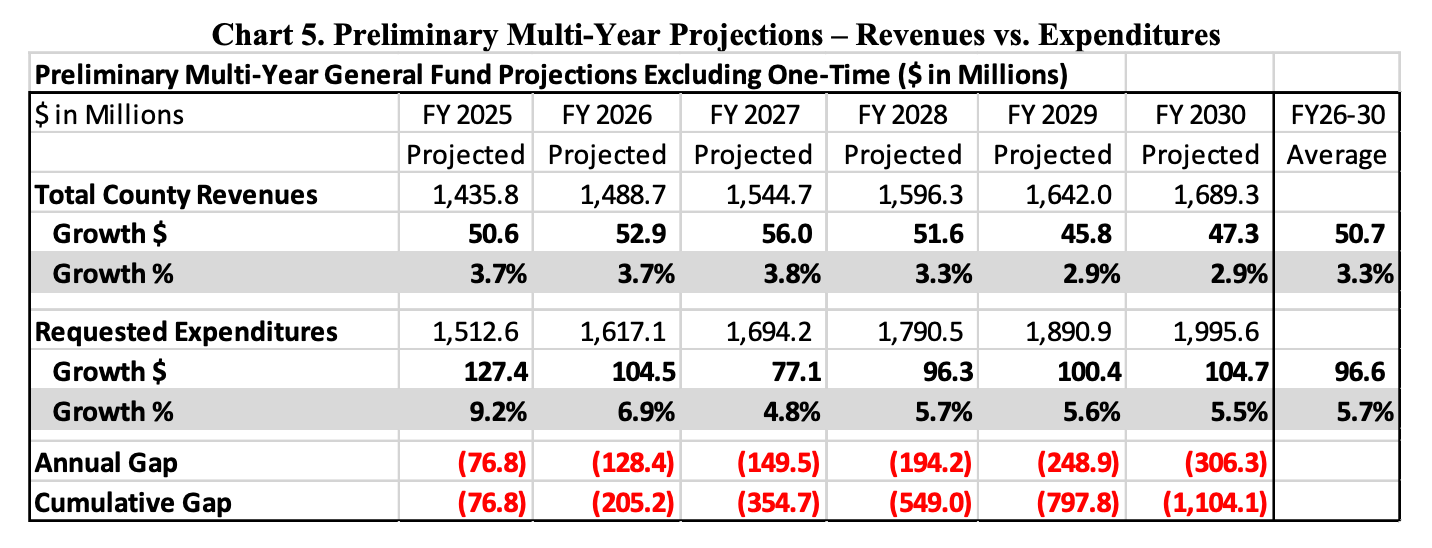From Half a Billion to Over a Billion: A Fiscal Reality Check for Howard County
Examining the Stark Contrast Between Conservative HoCo By Design Projections and Official Spending Affordability Estimates
HoCo By Design is Howard County’s 20-year projection of land-use plan. A general plan lays out a long-term projection of a jurisdiction’s use of land for residential, business, recreation, infrastructure and other needs based on various economic and demographic factors. HoCo By Design was signed into law on October 19, 2023.
The plan is based on a rosy and extremely optimistic fiscal impact analysis that projects a net positive fiscal impact that increases to nearly $75 million by 2040, with an average annual revenue of $52.5 million. The following table is from the county’s fiscal impact report.
I laid out my criticism and concerns about the plan here. The fiscal assumptions employed to project 20 years into the future are fraught with several flaws.
Specifically:
First and foremost, the fiscal impact report assumes that residential development pays for itself. This is problematic because of the last two bullet points in this list.
No credible corporation or any entity with fiduciary responsibility can make predictions 20 years into the future with the level of precision provided by the plan.
The fiscal analysis did not employ representative historical values. Instead of using the average results of several years of historical data, it uses just the FY2023 budget to predict the next 20 years.
The HCPSS projections have several issues. First, it under-predicts the per student operating cost. Second, it assumes that half of the capital costs will be financed by debt. Third, it under-predicts the amount of needed systemic renovations. Fourth, it under-predicts the student generation rates per new home.
The road infrastructure projections assume that 100% of the capital costs for new roads are paid by debt.
My conservative model predicted nearly half a billion in new debt by FY2040. This conservative assumption takes into account factors not taken into account by the county’s fiscal impact analysis. First, the County and State funding needed to operate the school system. Second, it uses 100% PAYGO to fund road and school construction. Third, the per-student school construction cost is much more accurate than used by the county.
Compare this to the county’s Spending Affordability Advisory Committee report of FY2025. This analysis paints a much more troubling picture. The report states that “multi-year model, based on input from all departments, agencies, and educational institutions, demonstrates that anticipated expenditures will continue to significantly exceed projected revenues. The annual deficit is projected to range between $77 million and $306 million, absent any gap closing strategies. Without corrective action, the cumulative deficit could grow and exceed $1 billion by FY 2030.”
Of course the county’s flawed planning assumptions and irresponsible stewardship of taxpayer dollars are evident by a now-withdrawn legislation proposed by Senator Clarence Lam. HoCo 12-25 would have authorized the county to allocate school surcharge fees for purposes of road construction and improvement projects.
If the county’s fiscal assumption is that residential development pays for itself, why does money collected for schools need to be used to pay for roads?
Howard County’s infrastructure is declining. Schools are overcrowded, our roads are crumbling, and other public facilities are strained. Meanwhile our taxes keep going up. There is a gross misallocation of resources. Developers keep receiving profit subsidies through favorable land-use and zoning decisions that have a direct economic and fiscal impact on our budget. We are building in permanent damage to our community and it is time to reverse course.








Interesting article Hiruy your conclusion is absolutely correct. "Developers keep receiving profit subsidies through favorable land-use and zoning decisions that have a direct economic and fiscal impact on our budget"
Brian